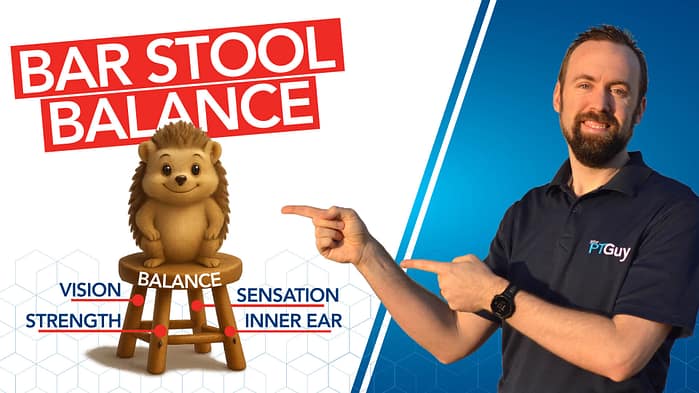
Ever Feel a Little Wobbly?
Do you know how to improve your balance? Do you feel unsteady? Have you had a fall? Or maybe you just feel like you’re auditioning for a role as a baby giraffe? Here’s the truth: balance isn’t magic—it’s mechanics. And if you want to stay upright, you need to understand the four-legged stool of balance — what makes it workin the first place.
Balance Is Like a Four-Legged Stool
Think of your body’s balance like a sturdy four-legged stool. All four legs need to work. Lose one? You might wobble. Lose two? You’re in trouble. Lose three? Well, let’s just say that stool is now modern art lying on the floor.
The four legs of balance are:
Muscular System
Sensation
Vision
Vestibular (Inner Ear)

Let’s break it down (without you breaking down in the process).
Leg #1: Muscular System
Strong muscles = strong balance. Weak muscles = hello, floor.
Your strength, posture, and flexibility all play a role. If your quads, glutes, and core aren’t doing their job, you won’t be able to make the quick corrections that keep you upright. And without flexibility, your body can’t move into the right positions to stabilize you.
Pro tip: Every time you sit or stand, you’re training your balance. If you want to go deeper, I cover this in my free webinar, 3 Secrets to a Fall Proof Life—it’s like a tune-up for your muscles (minus the grease).
Leg #2: Sensation
Ever try walking in the dark without bumping into something? That’s your sensory system at work.
Your nerves and receptors tell your brain where your body is in space—even with your eyes closed. If this system weakens, your brain basically loses its GPS. And when that happens, you’re more likely to trip, stumble, or grab the nearest unsuspecting houseplant for support.
Leg #3: Vision
Your eyes aren’t just for Netflix—they’re balance superstars.
Vision helps you orient yourself and stabilize while moving. That’s why people with vision loss are at higher fall risk. No shame in rocking those glasses—think of them as balance boosters.
Leg #4: Vestibular (Inner Ear)
Ah, the vestibular system: two tiny but mighty balance engines hiding inside your skull.
When both engines are humming at equal speed, life’s good. But if one sputters? Suddenly you feel like you’re walking sideways—or worse, you meet the dreaded “V” word: Vertigo. Trust me, it’s about as fun as a rollercoaster you never wanted to ride.
What Happens to Balance As We Age?
Unfortunately, each of these four systems—muscle, sensation, vision, and vestibular—declines over time. The sneaky part? You don’t always notice until a fall happens.
That’s why regular balance check-ups with your doctor or physical therapist are crucial. Think of us as your “stool inspectors.” We make sure all four legs are solid before you topple.

How to Improve Your Balance
Here’s the good news: balance can be trained! Over the next few posts, I’ll break down specific exercises and strategies for strengthening each leg of the stool.
But if you want a head start (and fewer close calls with the floor), join me for my free webinar: 3 Secrets to a Fall Proof Life. You’ll learn practical strategies you can start today—no boring medical jargon, just real-world tips with a sprinkle of PT humor.
Stay Upright, Stay Independent
Balance isn’t about perfection—it’s about prevention. By keeping all four legs of your balance stool strong, you reduce your fall risk, stay independent, and maybe even impress your grandkids with how steady you are.
So don’t wait until your stool collapses—watch my free webinar and start building your Fall Proof Life today.
